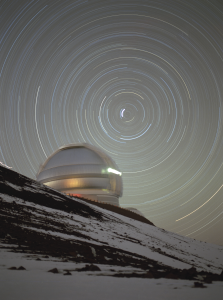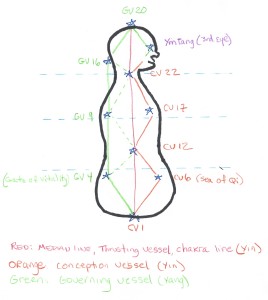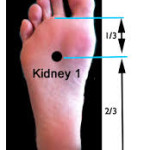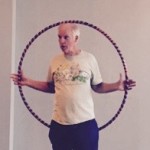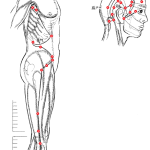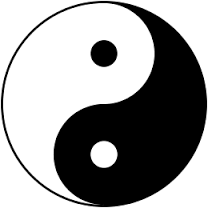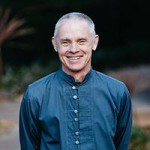Exploring and Embodying Three Dimensions
In the previous post we explored the micro-cosmic orbit as a means to refine our focal attention (samadhi) through bringing our attention to specific points along the orbit and linking these points into lines, arcs and circles. As we work more deeply this way, we may discover that we can find these points at three levels. The first is out beyond the confines of the skin, in an ‘orbit’ in the energy field around the body. The second is directly on the skin, where an acupuncturist or shiatsu practitioner would apply needles or pressure. The third is in the interior of the body along the planes of fascia interwoven through the organs, blood vessels and nerves. When we can feel all three of these levels simultaneously, we are inhabiting our spherical energy field and can begin to fully realize the possibilities of having three dimensional/spatial sensitivity, perception and consciousness.
 The girdle vessel (Dai Mai,) the fourth vessel we use, is a latitude line and is essential in finding our three dimensional perceptual field. This yang vessel pairs with the yin ‘thrusting vessel, the vertical center axis, creating horizontal stability, and allowing us to rotate/twist. Rotation inherently builds the third dimension of depth ( A circle has length and width. To create a sphere you add depth. ) and is the gateway to cosmic awareness as well as a more vibrant embodied presence.
The girdle vessel (Dai Mai,) the fourth vessel we use, is a latitude line and is essential in finding our three dimensional perceptual field. This yang vessel pairs with the yin ‘thrusting vessel, the vertical center axis, creating horizontal stability, and allowing us to rotate/twist. Rotation inherently builds the third dimension of depth ( A circle has length and width. To create a sphere you add depth. ) and is the gateway to cosmic awareness as well as a more vibrant embodied presence.
Rotation drives the whole manifest universe. In our solar system, the planets spiral around 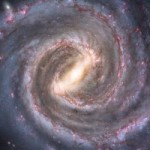 the sun. In our Milky Way galaxy, the stars, including our sun, spiral around a center (probably a giant black hole! If you can find Sagittarius in the night sky, and you will probably have to wait until next summer, look through and imagine 26,000 light years off in the distance.) The earth rotates on its own axis creating weather patterns as well as a sense of day and night.
the sun. In our Milky Way galaxy, the stars, including our sun, spiral around a center (probably a giant black hole! If you can find Sagittarius in the night sky, and you will probably have to wait until next summer, look through and imagine 26,000 light years off in the distance.) The earth rotates on its own axis creating weather patterns as well as a sense of day and night.
The spinning top (one of the oldest toys known to humans, found in archeological sites all over the world) demonstrates the cosmic principle in physics we are embodying. The faster it rotates, the more stable the vertical line. When the top slows down it starts to wobble and when it stops spinning, it falls over. To keep the rotation, you need to keep feeding it with energy. The bicycle uses this same principle, flipped 90 degrees. Another aspect we explore is the radius of the horizontal circle. Rotation pushes from the center outward (yang) in what is called centrifugal force. As this is counterbalanced by the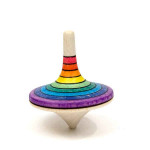 yin centripetal (center seeking) force, we can change the volume of the energy field by playing with this ‘expanding – condensing’, yang – yin relationship.
yin centripetal (center seeking) force, we can change the volume of the energy field by playing with this ‘expanding – condensing’, yang – yin relationship.
In this top, the widest circle with the most outward thrust, the purple one, is below the center of the vertical axis. Lowering the center of gravity adds even more stability, which is why we emphasize the lower dantien in our breathing, movement and meditation practice. When we discover how to work with this principle in the energy field, our twisting poses can actually help expand the body. If we work muscularly, you will feel constricting in twisting poses.
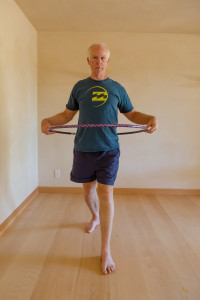 Traditionally the ‘dai mai’ girdle vessel surrounds the body at the level of the pelvis in the lower dantien. but we can move our attention to awaken other ‘latitudes’ of the body. To begin in the feet, stand with the right foot forward, the left foot back, as if you are about to move into a standing twist (without the forward bend), but haven’t yet begun. Before you move any further, imagine a spiraling coil of energy beginning below the floor (the Antarctic Circle) and traveling up the center. Notice how this mimics the girdle vessel. Now imagine the coils widening as they rise up from the base ( moving toward the equator), as the yang energy expands outward. The girdle vessel is very yang so this is quite natural. Feel the energetic volume expanding and condensing with the breath, but slowly expanding in overall volume
Traditionally the ‘dai mai’ girdle vessel surrounds the body at the level of the pelvis in the lower dantien. but we can move our attention to awaken other ‘latitudes’ of the body. To begin in the feet, stand with the right foot forward, the left foot back, as if you are about to move into a standing twist (without the forward bend), but haven’t yet begun. Before you move any further, imagine a spiraling coil of energy beginning below the floor (the Antarctic Circle) and traveling up the center. Notice how this mimics the girdle vessel. Now imagine the coils widening as they rise up from the base ( moving toward the equator), as the yang energy expands outward. The girdle vessel is very yang so this is quite natural. Feel the energetic volume expanding and condensing with the breath, but slowly expanding in overall volume
To awaken the front body-yin energy field, we can take the hoop forward to fully engage the arms and shoulders. Now imagine the hoops extends through the back body, receiving the rising spiral and expanding as the action of twisting. 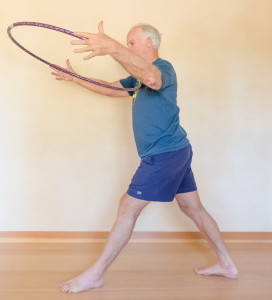
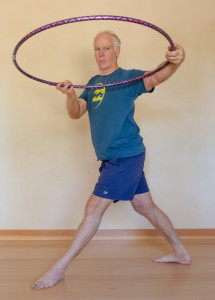 Most students eventually leave half of the body behind and end up contracting rather than expanding, especially along the spine column. Imagine the center of the spinal canal opening outward in an expanding circle/spiral, melting the tissue, feeling spaciousness, transcending the limitations of structure.
Most students eventually leave half of the body behind and end up contracting rather than expanding, especially along the spine column. Imagine the center of the spinal canal opening outward in an expanding circle/spiral, melting the tissue, feeling spaciousness, transcending the limitations of structure.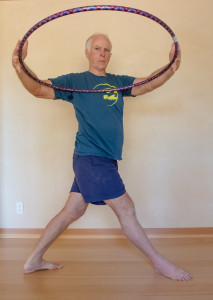 (My front foot turns out much more than average to release the inner groin. Don’t feel you have to imitate this, but find out for yourself where openness and balance meet.) The hoop is moved to the front to expand the yin/organ/front body qi field and expand the ‘wings’ of the body, but also feel the back body softening and opening. This feeling can be evoked in sitting, lying and inverted twists as well. If you do not have a hula hoop handy, you can also use a thera-ball to find the volume.
(My front foot turns out much more than average to release the inner groin. Don’t feel you have to imitate this, but find out for yourself where openness and balance meet.) The hoop is moved to the front to expand the yin/organ/front body qi field and expand the ‘wings’ of the body, but also feel the back body softening and opening. This feeling can be evoked in sitting, lying and inverted twists as well. If you do not have a hula hoop handy, you can also use a thera-ball to find the volume.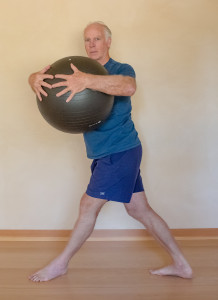
Another key component awakened here is the Pericardium 8 point, PC-8 (or P-8) in the center of the palms. Analagous to the K-1 points on the feet, P-8 is a gateway between the inner and outer qi fields. The 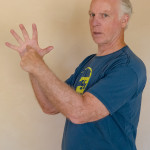 Pericardium, the fascial connective tissue membrane surrounding the heart, arises embryologically from the same cells and tissues that create the diaphragm and liver. The ‘heart protector’ literally does this, on many levels. As someone with a well-armored heart, I am finding that opening and nurturing the heart protector so that is does its job with over doing it is awakening a level of sweet vulnerability that is both precious and scary.
Pericardium, the fascial connective tissue membrane surrounding the heart, arises embryologically from the same cells and tissues that create the diaphragm and liver. The ‘heart protector’ literally does this, on many levels. As someone with a well-armored heart, I am finding that opening and nurturing the heart protector so that is does its job with over doing it is awakening a level of sweet vulnerability that is both precious and scary.
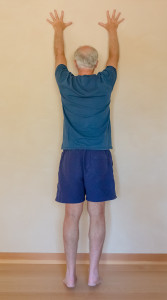 In acupuncture, the pericardium meridian is part of the JueYin channel and connects all the way through the femoral canal to the legs. For those of you who have been practicing ‘climbing the wall’ for the last few years, you can actually trace the whole fascial continuity of the Jue Yin. (Use imagination to fill in the blanks.) Rise up from K-1 (not the heels, even though they do rise on their own) (DFL for those of you who know Tom Myers’ ‘Anatomy Trains’ system) to P-8, passing through liver, diaphragm and pericardium.
In acupuncture, the pericardium meridian is part of the JueYin channel and connects all the way through the femoral canal to the legs. For those of you who have been practicing ‘climbing the wall’ for the last few years, you can actually trace the whole fascial continuity of the Jue Yin. (Use imagination to fill in the blanks.) Rise up from K-1 (not the heels, even though they do rise on their own) (DFL for those of you who know Tom Myers’ ‘Anatomy Trains’ system) to P-8, passing through liver, diaphragm and pericardium.
You can also track the qi from P-8 back into the body horizontally, again using the wall.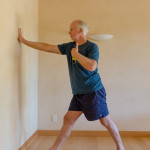 Using the tip of the middle finger of your other hand (PC-9) to feel the connections, trace the qi from the the wall and P-8 into the area around the pec minor muscle and then go inside the body to the pericardiam itself, along with the liver and diaphragm. Use the breath and your imagination. Then go back and try the twistings shown above with these new perceptions.
Using the tip of the middle finger of your other hand (PC-9) to feel the connections, trace the qi from the the wall and P-8 into the area around the pec minor muscle and then go inside the body to the pericardiam itself, along with the liver and diaphragm. Use the breath and your imagination. Then go back and try the twistings shown above with these new perceptions.
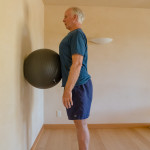 To continue our building of a three dimensional perceptual qi field, we can return to the thera-ball to provide sensation and visualization. I like the feel of my third chakra having organ support, so I find placing the ball there and using a wall creates a powerful presence on the inside. Embryologically speaking, this is the extemely yin yolk sac which becomes the entire gut body. The conception vessel points on the micro-cosmic orbit are stimulated by the ball, bringing sensation and perception here. The liver comes from the yolk sac, so I can use this position to also find the Jue Yin channel we explored above. Lying
To continue our building of a three dimensional perceptual qi field, we can return to the thera-ball to provide sensation and visualization. I like the feel of my third chakra having organ support, so I find placing the ball there and using a wall creates a powerful presence on the inside. Embryologically speaking, this is the extemely yin yolk sac which becomes the entire gut body. The conception vessel points on the micro-cosmic orbit are stimulated by the ball, bringing sensation and perception here. The liver comes from the yolk sac, so I can use this position to also find the Jue Yin channel we explored above. Lying 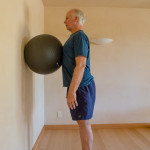 over the ball in a forward bend creates a similar feeling, with even more yielding and softening to the yang back body erector muscles. By moving the ball to the sternum, I can activate a new set of points on the conception vessel and engage the inner tissues surrounding the 4th chakra
over the ball in a forward bend creates a similar feeling, with even more yielding and softening to the yang back body erector muscles. By moving the ball to the sternum, I can activate a new set of points on the conception vessel and engage the inner tissues surrounding the 4th chakra
If I want to build up my back field perception, I use the ball from behind and awaken sensation on the yang Governing Vessel.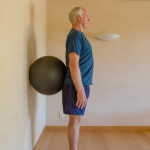 Here I have dropped it a bit lower to find the sacral-lumbar junction and here I can feel the possibility of both lumbar flexion and extension, from S curve to C curve and back. The very important GV-4
Here I have dropped it a bit lower to find the sacral-lumbar junction and here I can feel the possibility of both lumbar flexion and extension, from S curve to C curve and back. The very important GV-4 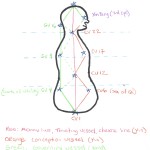 ‘gate of vitality’ is here The inner abdominal space also opens and the front back and center plane begin to become conscious. This becomes trickier as you move upwards towards the liver. You can place the ball anywhere and feel different points coming alive. Feel their inner as well as outer presence. Back support can also help open the front. I have
‘gate of vitality’ is here The inner abdominal space also opens and the front back and center plane begin to become conscious. This becomes trickier as you move upwards towards the liver. You can place the ball anywhere and feel different points coming alive. Feel their inner as well as outer presence. Back support can also help open the front. I have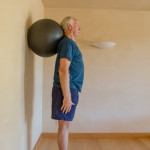 been trying to open my throat more for my sax sound and using the ball (or any elastic support) helps soften and melt tight tissue.
been trying to open my throat more for my sax sound and using the ball (or any elastic support) helps soften and melt tight tissue.
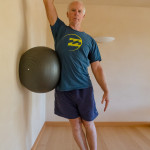 Fish body support, opening some Gall Bladder Meridian points is another way to use the ball. I am using the wall, but this can be done on the floor as well, with slightly different effects. All of these ways of playing with the three dimensional field are ways of awakening and establishing a dynamic energetic field, centered in your heart, and radiating out throughout the whole of the cosmos. When you are out in Nature, feel this. When you are out and about in the human sphere, feel how you respond. It is fascinating to see what happens.
Fish body support, opening some Gall Bladder Meridian points is another way to use the ball. I am using the wall, but this can be done on the floor as well, with slightly different effects. All of these ways of playing with the three dimensional field are ways of awakening and establishing a dynamic energetic field, centered in your heart, and radiating out throughout the whole of the cosmos. When you are out in Nature, feel this. When you are out and about in the human sphere, feel how you respond. It is fascinating to see what happens.


